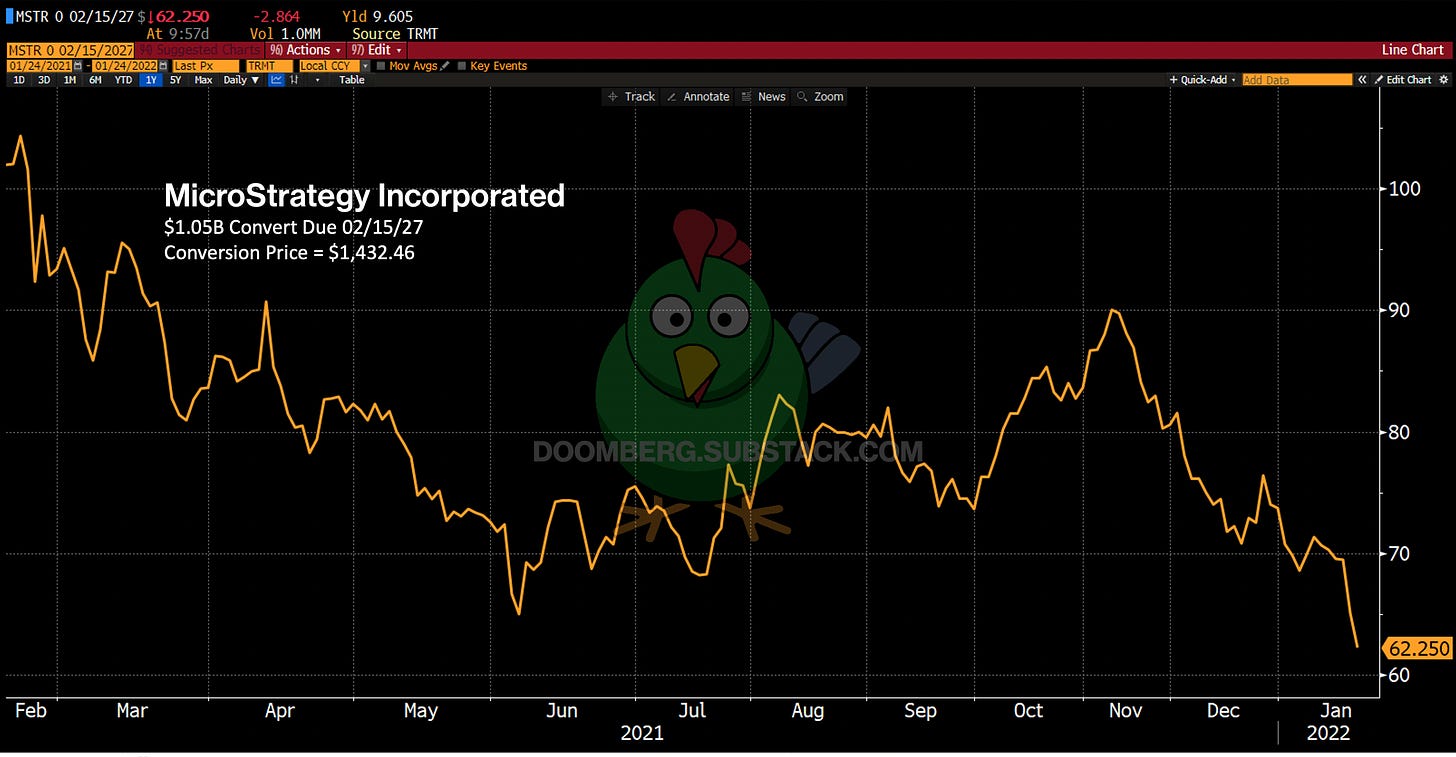https://doomberg.substack.com/p/dollars-ex-machina
“When your outflow exceeds your income, your upkeep becomes your downfall.” – Jim Rohn
In late 2016, we were approached by a brilliant entrepreneur with an interesting investment opportunity. We mask the full details here to protect anonymity but believe us when we say this person has a knack for being incredibly early to imminent megatrends at the bleeding edge of technical and social disruptions. His pitch involved a company he and some colleagues were starting that had something to do with “bitcoin,” which he described to us as a form of “crypto currency.” We knew precious little about bitcoin or crypto currencies back then, nor did we understand what the newly formed company intended to do, but in a classic “bet the jockey, not the horse” move, we agreed to participate in the seed round at the minimum investment level. We immediately marked this equity investment to zero on our personal balance sheets.
In the following months, we engaged in a series of philosophical conversations about crypto currencies with our friend to learn more. Concurrent with this quest for knowledge, the paper value of our modest investment began to soar, which had the understandable effect of increasing the urgency of our research. We distinctly recall drawing two circles on a piece of paper. In the circle on the left, we wrote “real economy,” while in the circle on the right we wrote “crypto universe.” We drew two pipes between the circles – one flowing into the crypto universe and the other flowing back to the real economy – and labeled both pipes with “fiat currencies.” While we understood how fiat currencies from investors could flow in, we failed to grasp what could be occurring within the crypto universe that would create more fiat currency for investors to take out at a later date. There seemed to be many brilliant people excited to be working in the space and using a technical language foreign to us, so we concluded that our inability to understand this rather pertinent issue was a fault of our own making.
Then bitcoin went bananas in late 2017.
They say we are shaped by our experiences, and as bitcoin went parabolic it certainly impacted us. Watching our modest foray into a little understood technology skyrocket in paper value several hundredfold left a jagged mark as it crashed with the rest of the crypto market back to where we had always kept it marked – zero. Along the way, we did make a few half-hearted efforts to get the outflow pipe turned on – life-changing fortunes are worth bending over and picking up, after all – but since we could not get an answer to our foundational question, we never held out much hope of converting paper into reality. There would be no lambos for the green chicken team.
It is through this tortured lens that we read with some interest a recent article by Sohale Mortazavi, published in the socialist magazine Jacobin. Sporting the provocative title Cryptocurrency Is a Giant Ponzi Scheme, the author pulls no punches in stating what he really thinks of the entire space. What caught our eye was his observation that cryptos aren’t merely a zero-sum game – in fact, inherent in the design of the entire system is a negative-sum occurrence in which the outflow pipe of fiat currencies available to investors must always be smaller than the inflow pipe (emphasis added throughout this piece):
“The majority of cryptocurrency mining is now conducted in commercial mining farms, essentially huge warehouses running thousands of high-powered computer processors day and night. The electricity expended mining Bitcoin and other cryptocurrencies is rapidly approaching 1 percent of global usage, which is famously greater than the total electricity consumption of many smaller developed nations.
Given that cryptocurrencies don’t produce anything of material value, this enormous waste of resources renders the whole enterprise a negative-sum game. Investors can only cash out by selling their coins to other investors — but only after the miners and various cryptocurrency service providers take the house’s rake. In other words, investors cannot — in the aggregate — cash out for even what they put in, as cryptocurrencies are inefficient by design.”
There’s simply no arguing that if one uses fiat currencies as the determining scorecard, the crypto universe is a Ponzi scheme. The structural costs of mining – which must ultimately be paid for using fiat – aren’t the only thing that shrinks the outflow pipe for regular investors. Outright theft of fiat deposits, whether via hacks, rug pulls, or illegal front-running by lawless market “participants” are a substantial drain on the total fiat floating around in the crypto universe.
Before the bitcoin maxis fill our comments with well-worn whataboutisms, we readily concede the real economy is filled with government-backed Ponzi schemes, legal or otherwise. Take the US Social Security system. New money will forever be needed to pay off old promises and absent the US government’s ability to print unbacked fiat, the entire edifice would collapse. But those systems are blessed by the state, and – by and large – the crypto universe is not. More critically, we believe precious few crypto participants today are in it to support their belief that the final chapter for fiat currencies has been written. They’re in it as a trade and are hoping to leave the crypto universe with more fiat in their traditional banking accounts than they entered with. Most won’t. If you don’t know who the sucker is at the digital poker table, you are probably a HODLer.
Just how much fiat is sloshing around in crypto universe? Because of the fraudulent sleight of hand of fiat clones called stablecoins, crypto investors routinely mark their books in fiat currencies like the US dollar, when in fact they should be marked in the underlying stablecoin, like tether. Bitcoin is not worth 36,000 US dollars, which is about where it is “trading” today. It is worth 36,000 tethers, the dominant underlying stablecoin in which it transacts.
On a recent appearance on the Crypto Critics’ Corner, which published yesterday, we discussed this issue at length (the hosts of the show, Bennett Tomlin and Cas Piancey, can be followed on Twitter here and here, respectively). If one assumes the total value of the crypto universe is marked at $2 trillion, and if the total amount of hard fiat (pun intended) in the system is the equivalent of only a few tens of billions of US dollars, then the leverage ratio of the crypto universe is enormous when measured in fiat. In a true market panic, which may or may not be unfolding as we publish this piece, we suspect many investors would be stuck holding the bag without recourse. These are largely unregulated markets where hacks, thefts, and total exchange collapses are routine.
Our focus on mapping the fiat currency moving in and out of the crypto universe leads us to update our readers on two of the highest profile names in this space: Michael Saylor, CEO of MicroStrategy, and Nayib Bukele, President of El Salvador. We had previously written about Saylor’s adventures with bitcoin here, and Bukele’s here. Both are facing renewed pressure as the crypto markets wobble, both are on the hook for substantial debts denominated in US dollars, and both risk potentially losing control – as unlikely as that might seem now.
For Saylor, we (and many others) have described the dangerous game he is playing, having issued $2.2 billion in dollar-denominated debt to buy bitcoin. This includes $1.7 billion in two convertible notes, which were then subsequently primed by the issuance of a $500 million senior secured straight bond above them in the capital table. The weakest of the convertible notes has a conversion price of $1,432 per share, and with MicroStrategy’s stock trading near $370 a share overnight, the convert option is deeply out of the money. As of yesterday’s close, the bonds are trading in distressed territory, catching only 62 cents on the dollar for a 9.6% yield to maturity.
As first pointed out to us by Mike Green on Twitter, Michael Kao – a convertible bond expert – has been speculating for many months that Saylor could lose control over MicroStrategy in the event of a deep drawdown in bitcoin’s value. Kao argues persuasively that Saylor’s fiduciary is not just to his shareholders, but also his debtholders, especially if the company enters a zone of insolvency. MicroStrategy owns more than 124,000 bitcoins, worth over $4 billion at today’s prices. Note that Saylor doesn’t own these bitcoins, the company does – making Saylor’s personal conviction less relevant. The company’s board might decide to turn off their laser eyes in a time of true crisis despite Saylor’s current position as board chair. If the company liquidated its bitcoin into a downdraft, we suspect we’d find out just how much fiat exists in the crypto universe rather quickly. MicroStrategy’s bondholders can’t be paid back in tethers, after all.

Michael Kao @UrbanKaoboy
MSTR-Painting Targets & The Negative Gamma Cascade (THREAD) There’s perhaps no bigger poster-child for crypto-hubris than the Lord of Cyber Hornets. Quoth he his AM: https://t.co/6auFVqQywqWith Bukele, his arrival on the bitcoin scene was a little puzzling to us at first, and our original predictions in the piece we linked to above have yet to play out. Luckily for us, it was among our earliest works and so most of you haven’t read it. Recent developments appear to lay bare his strategy. Like Saylor, Bukele has US dollar-denominated debt, but his situation is a little more urgent. In less than a year, El Salvador has a $800 million bond coming due, and it is currently priced in extremely distressed territory. When Bukele shocked the world with his adoption of bitcoin as legal tender in early June, that bond was priced to yield 6%. If an investor picked up the bond today and held it to maturity, they could expect a staggering 35% return – which says more about the risk of default than it does the attractiveness of the opportunity.
It probably didn’t help matters that Bukele tweeted “DGAF” in response to news that Moody’s issued a fresh warning on the country’s creditworthiness:

Investing.com @Investingcom
*MOODY'S DOWNGRADES EL SALVADOR SOVEREIGN DEBT DUE TO #BITCOIN TRADES https://t.co/EzswBLv06QBukele’s hubris likely derives from the revelation that the country intends to issue bonds backed by bitcoin, and to circumvent the traditional banks to do so:
“El Salvador’s national adoption of bitcoin was easily the most transformational cryptocurrency landmark in a year full of them. The use of bitcoin as legal tender seems poised to attract a wave of experiments and investment, while a program to mine bitcoin using volcanic energy could be a significant boost for the lower-income economy.
But El Salvador’s recently-announced “Bitcoin Bond” may be the most truly disruptive and empowering part of the project. By selling bitcoin-backed bonds through blockchain infrastructure, El Salvador will bypass the Wall Street banks and international institutions that have had a century-long choke hold on loans to developing economies. There are signs that this could escalate into a full-scale public battle as global financiers angle to retain control of the system.”
If we follow the fiat in this proposed offering, Bukele is encouraging fresh investors to come into the crypto universe with new money so he can turn around and use it to pay off his country’s debt. While he would like you to HODL, he literally can’t. While we admire the boldness of his gambit, it is unclear to us what Plan B is in the event of a true crypto washout. Like Saylor, his obligations are firmly entrenched in the real economy. If the leverage ratio of the crypto universe is as high as we suspect it is, the risk of an unraveling is very real.
If you enjoyed this piece, please do us the HUGE favor of simply clicking the LIKE button!





No comments:
Post a Comment